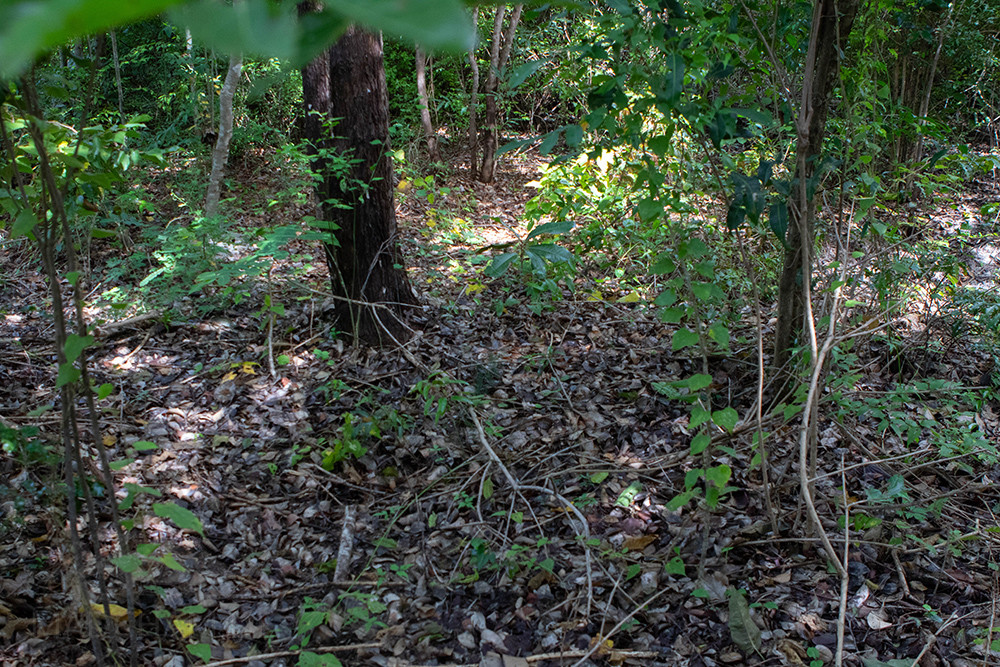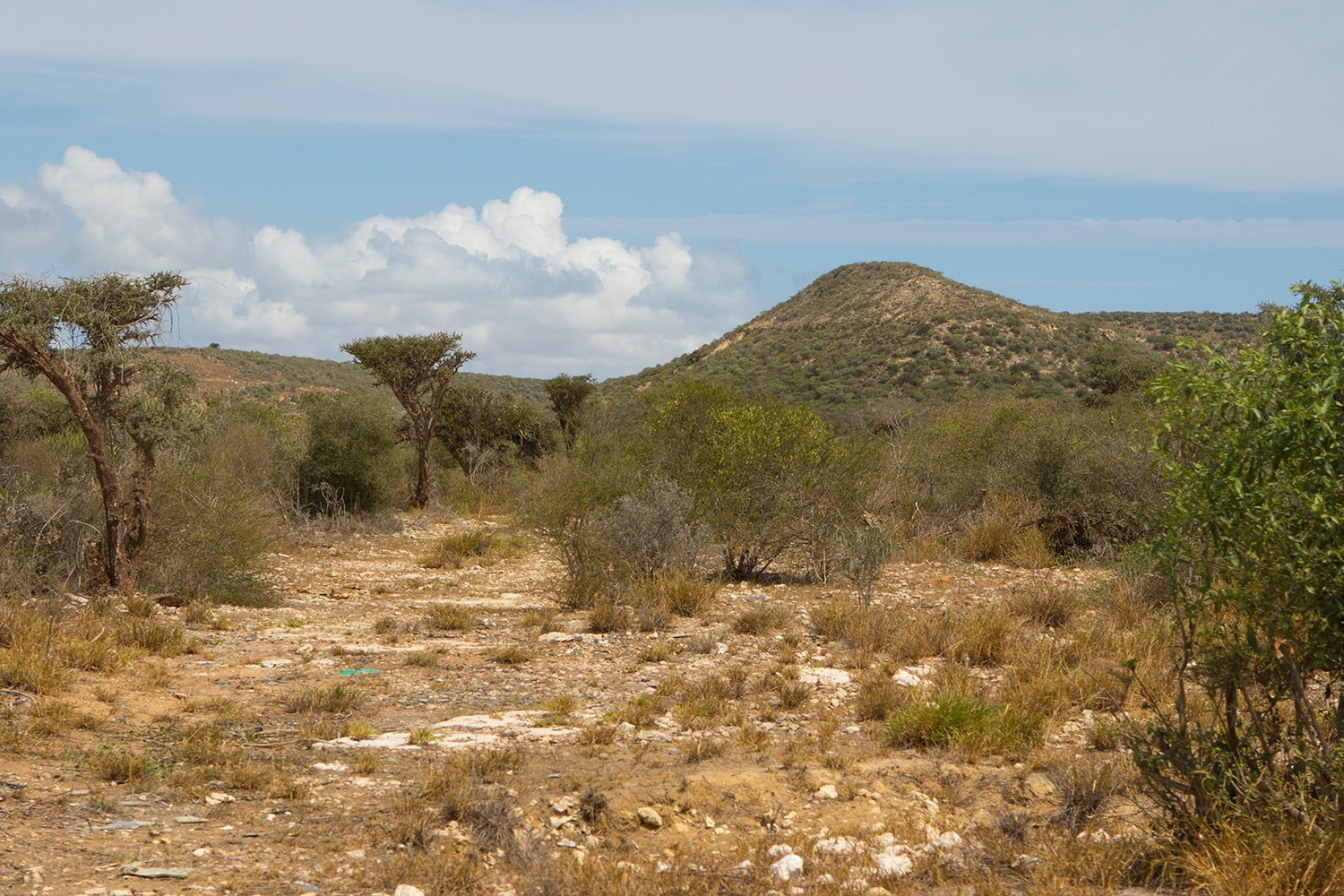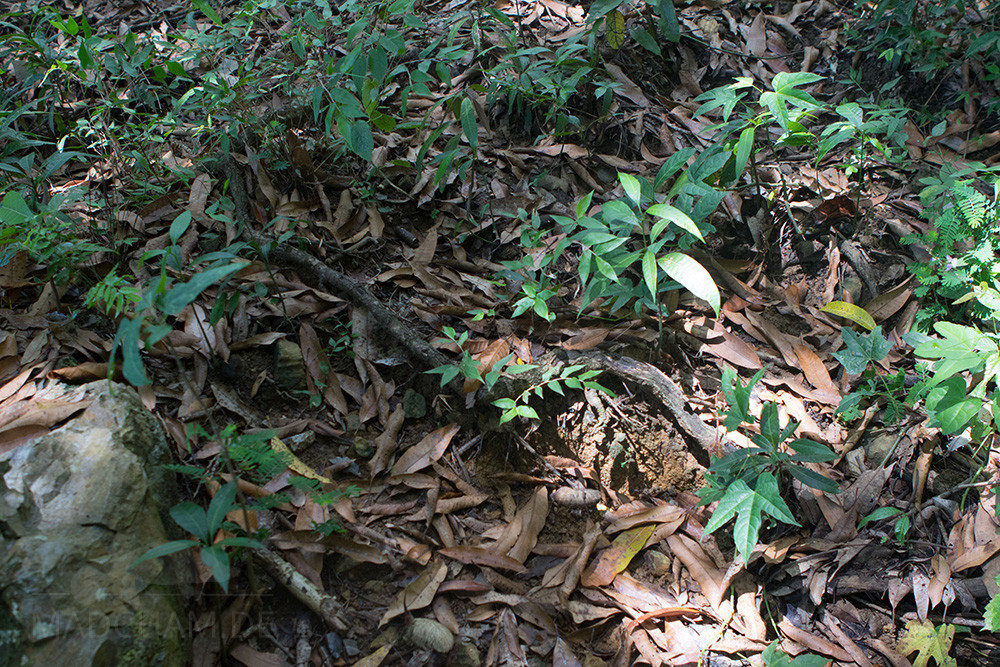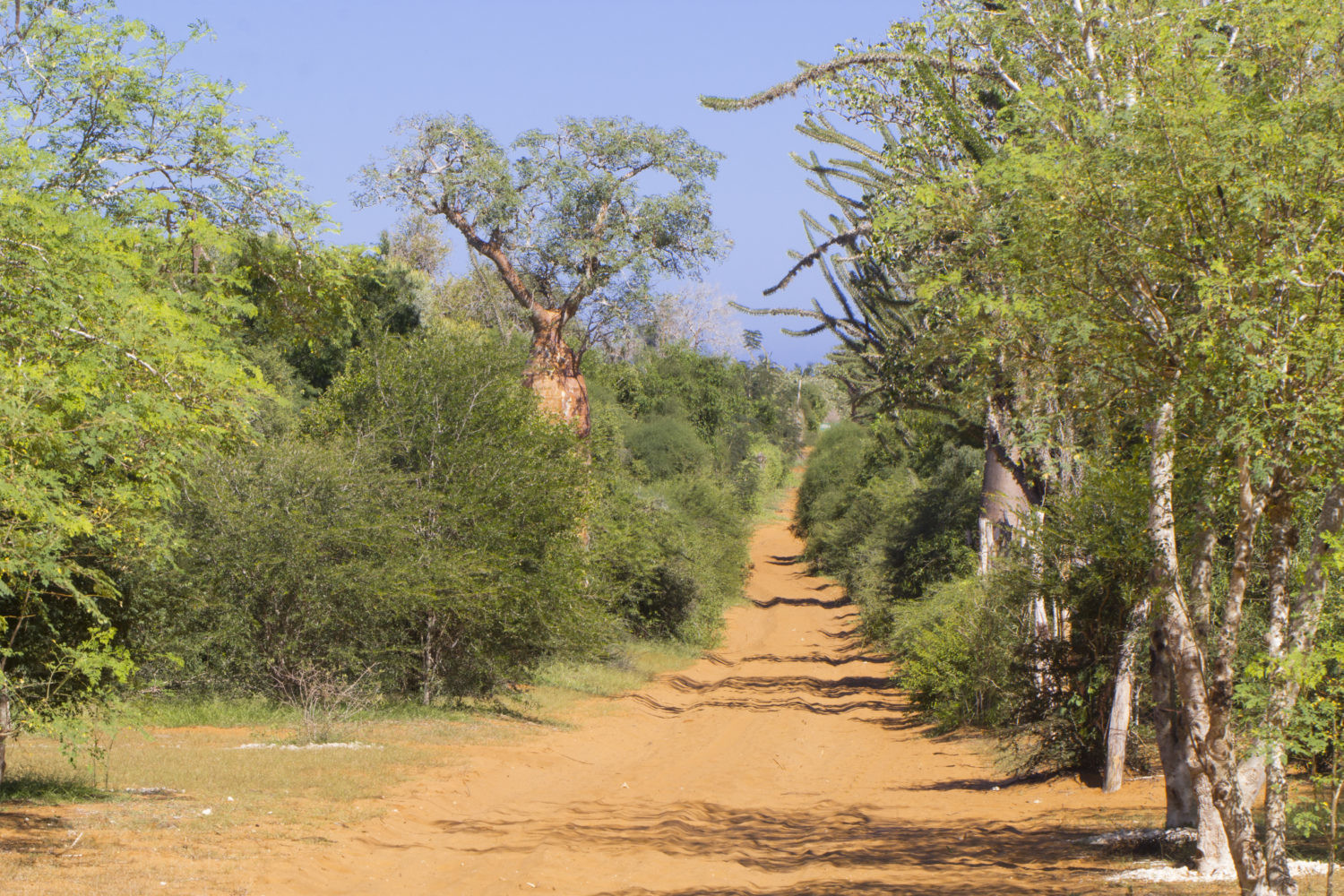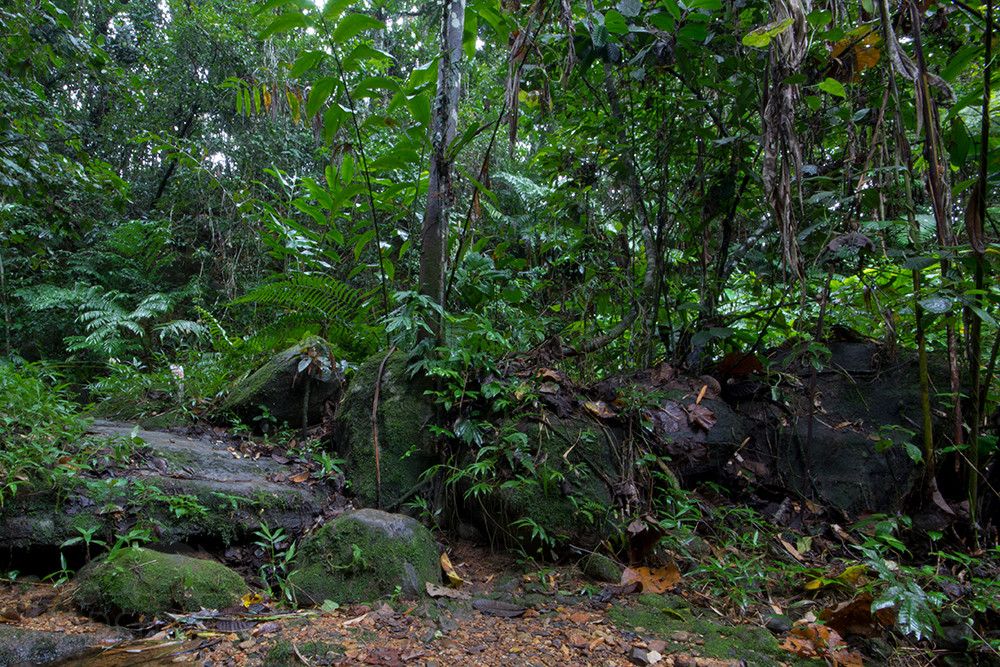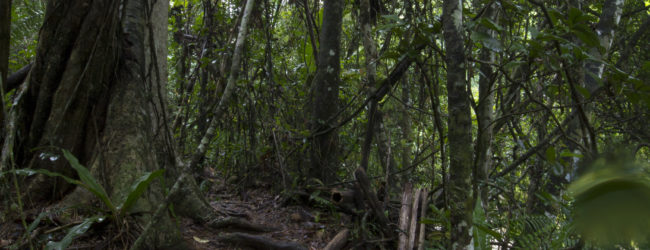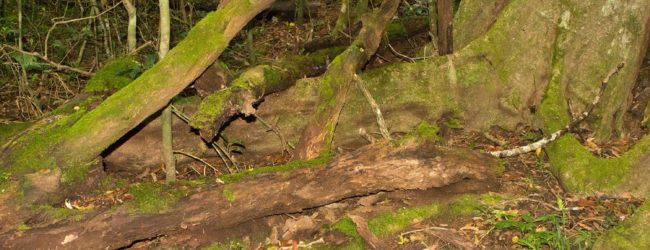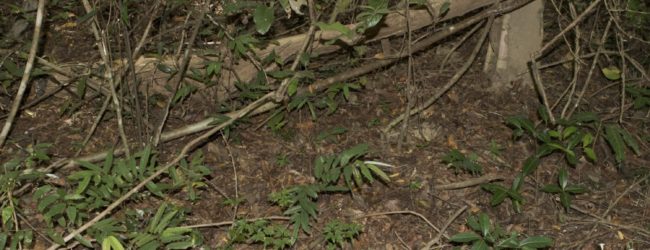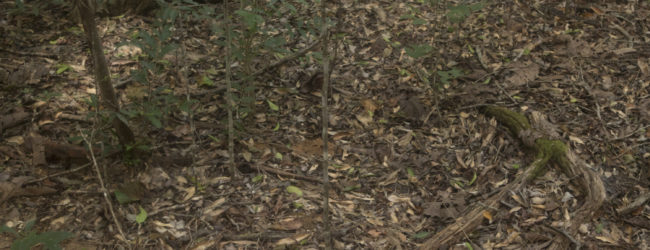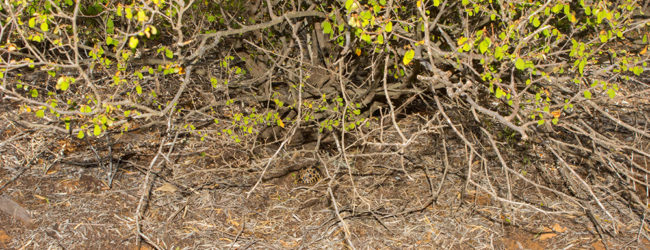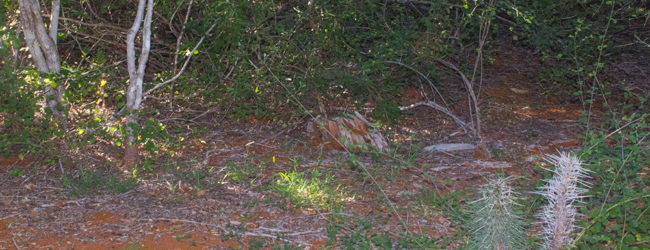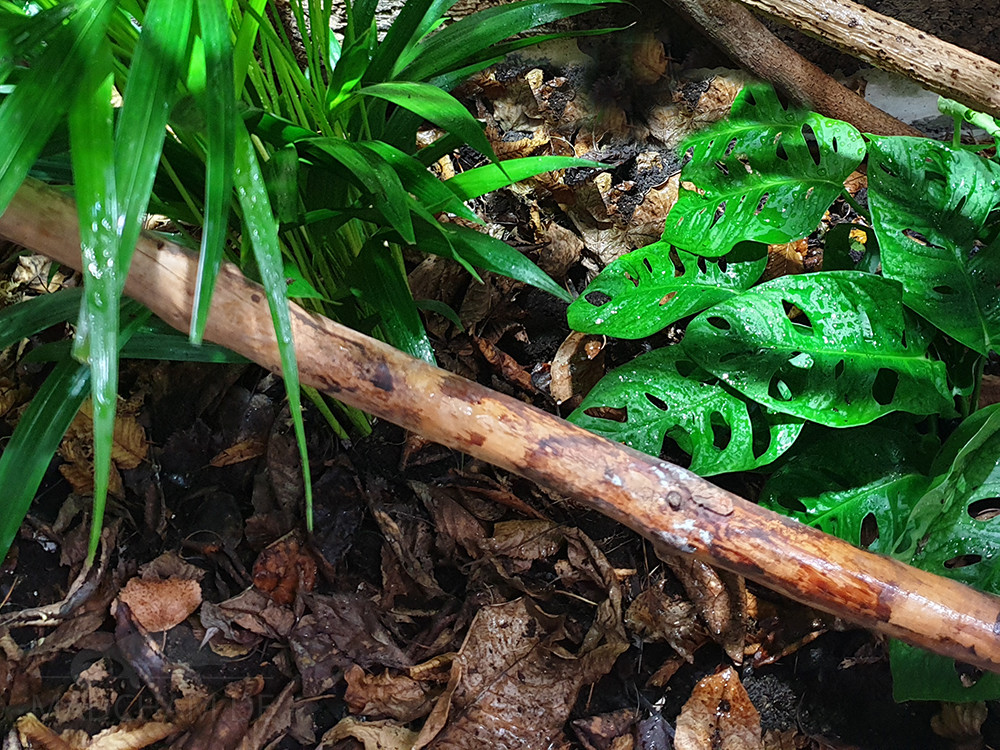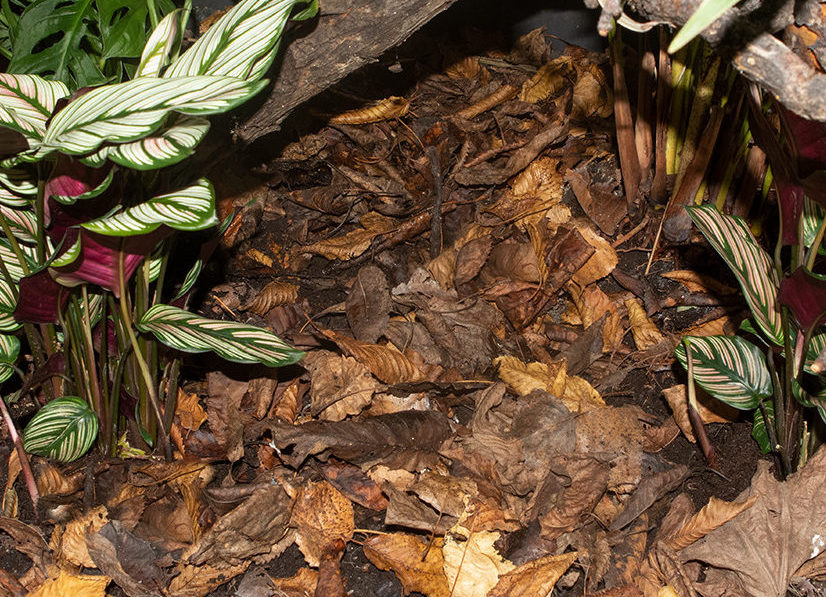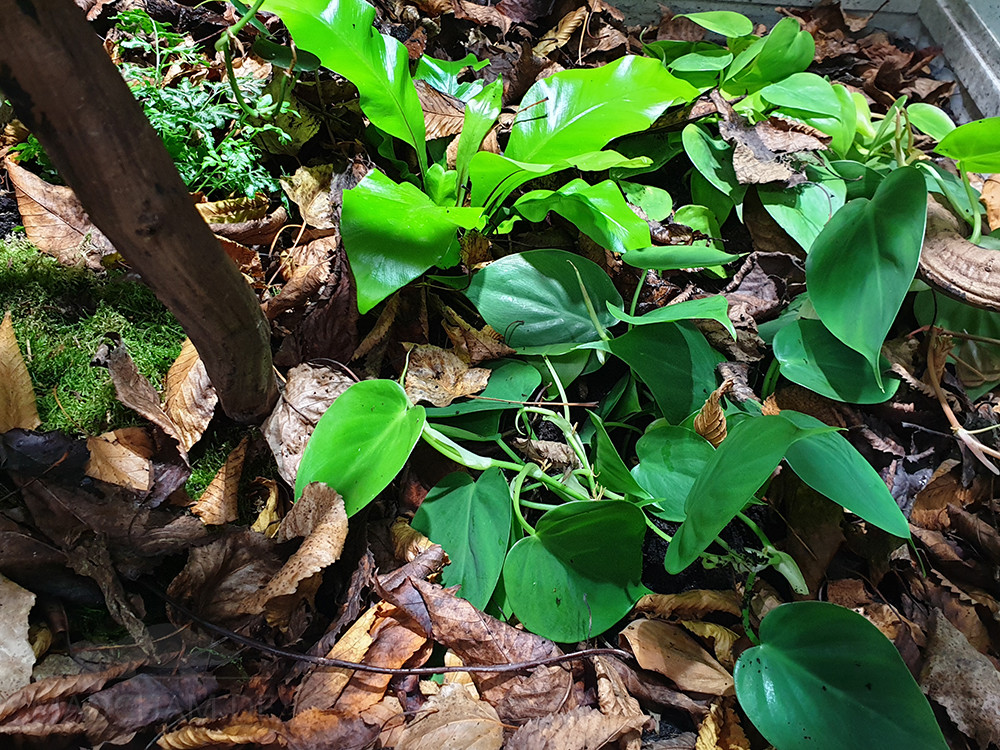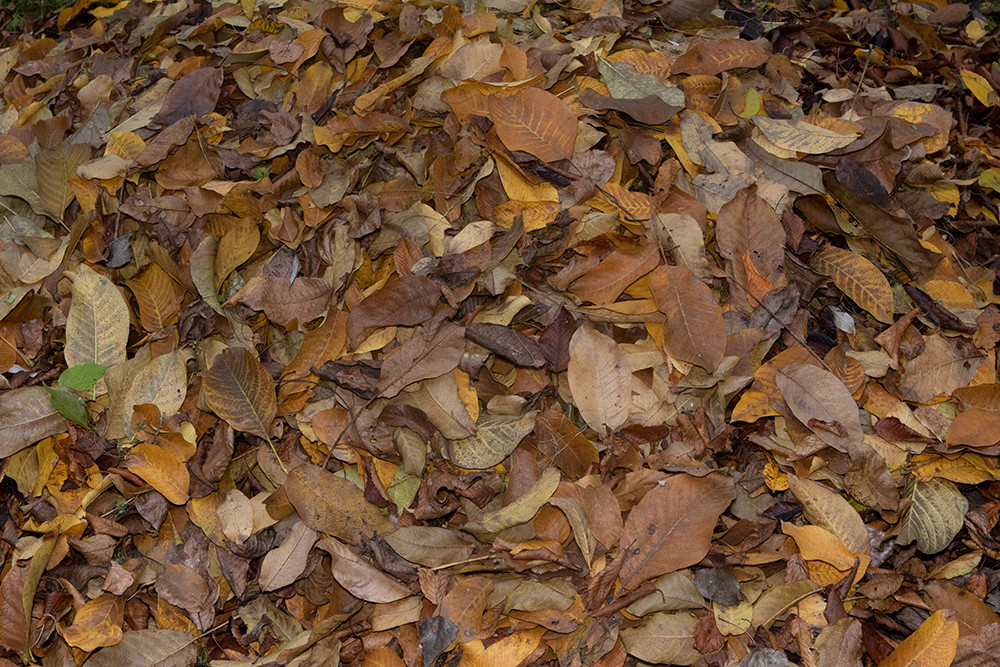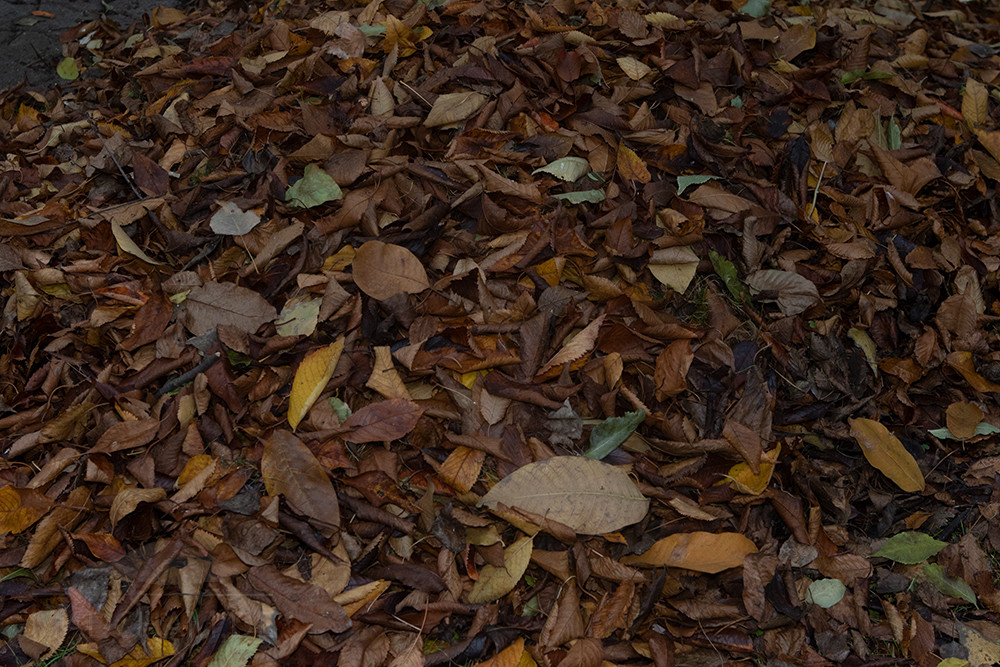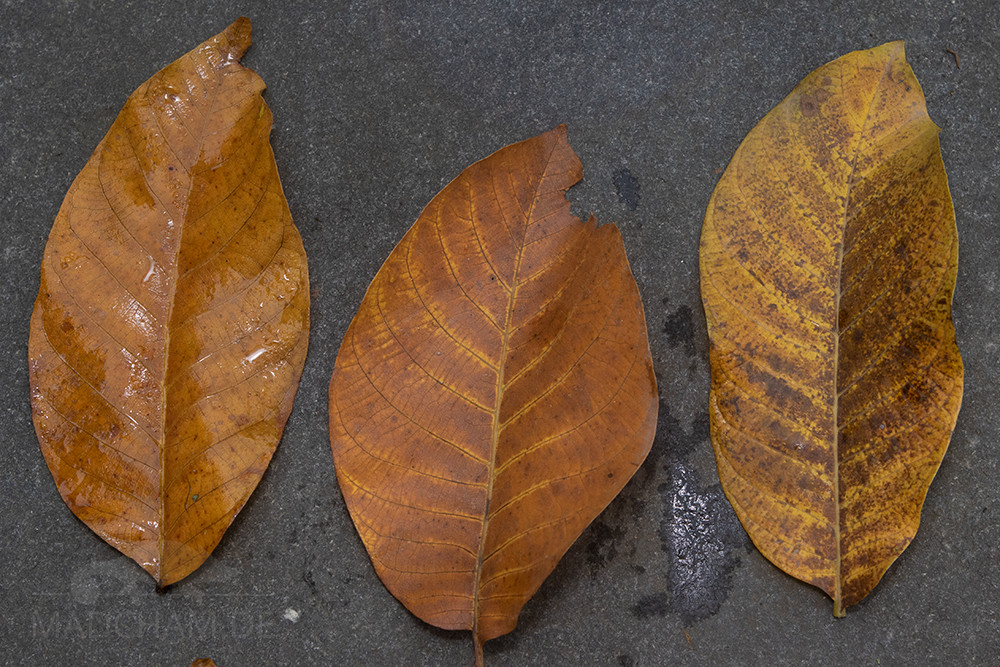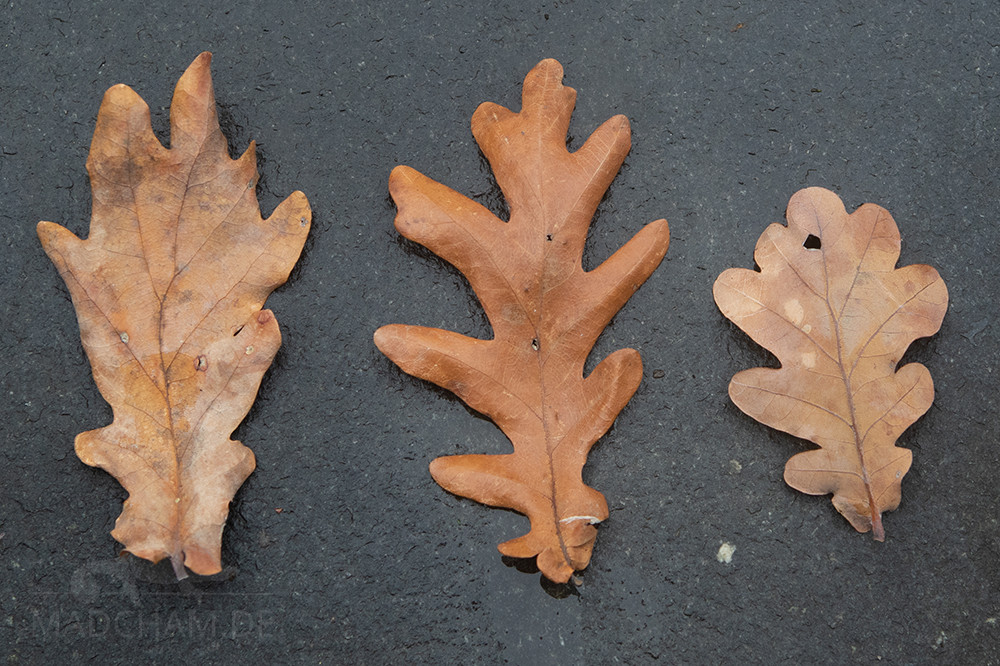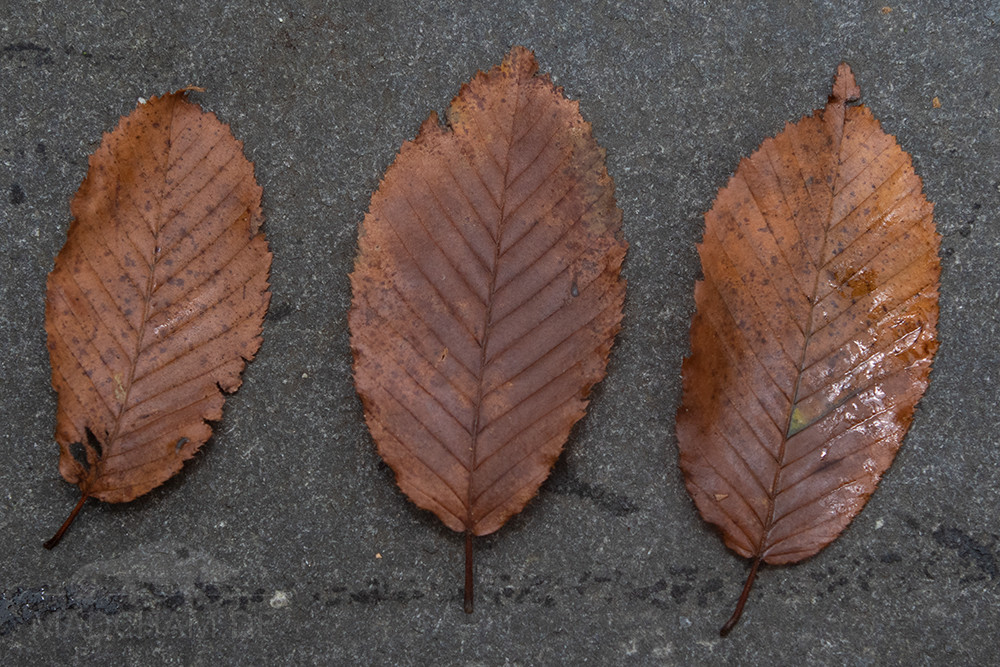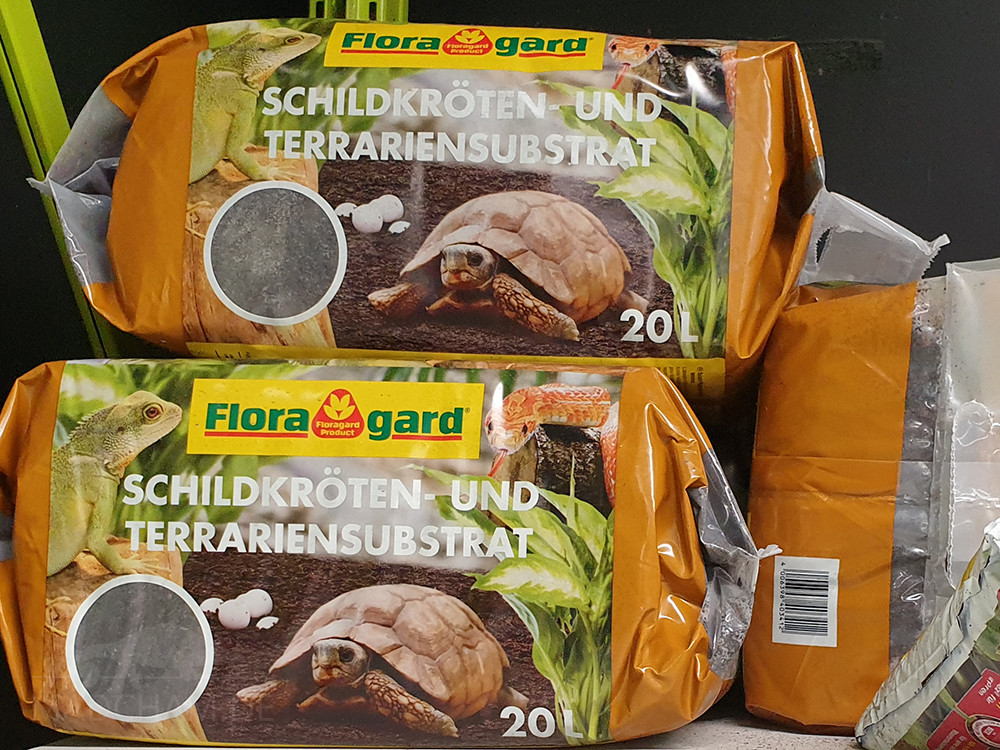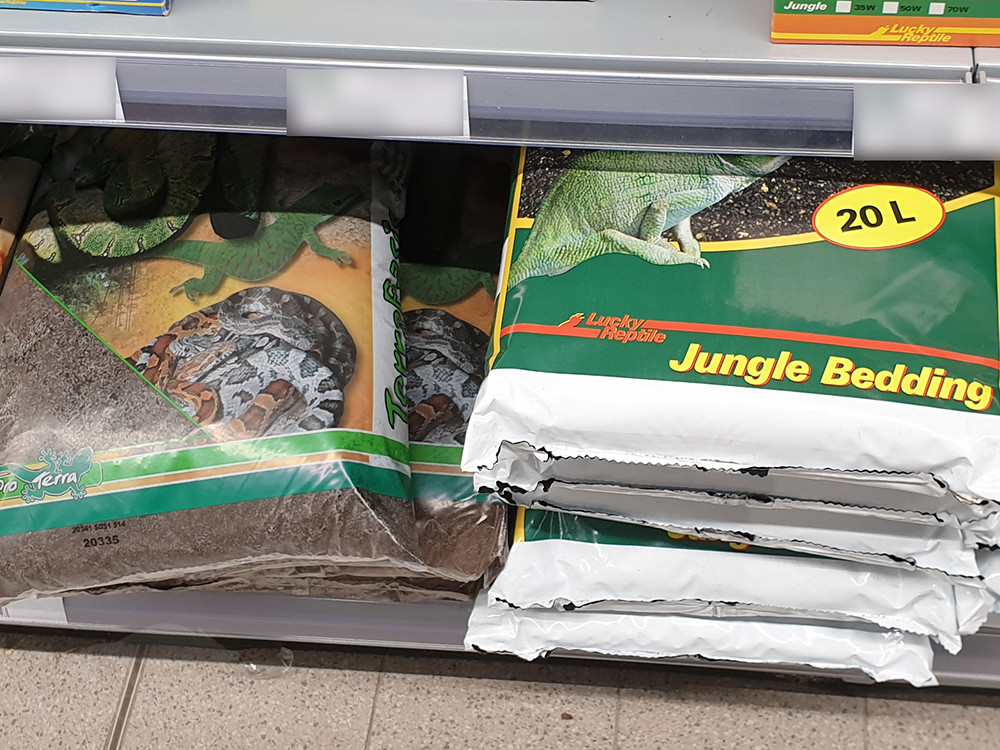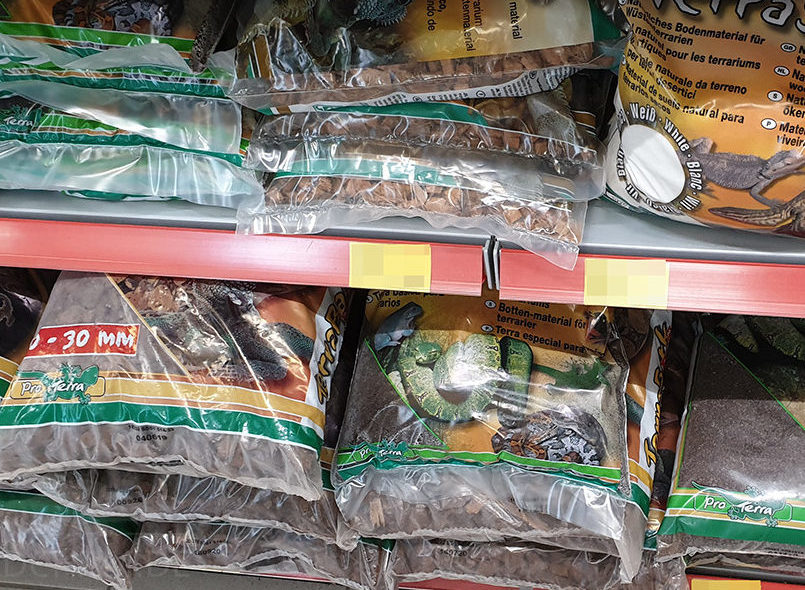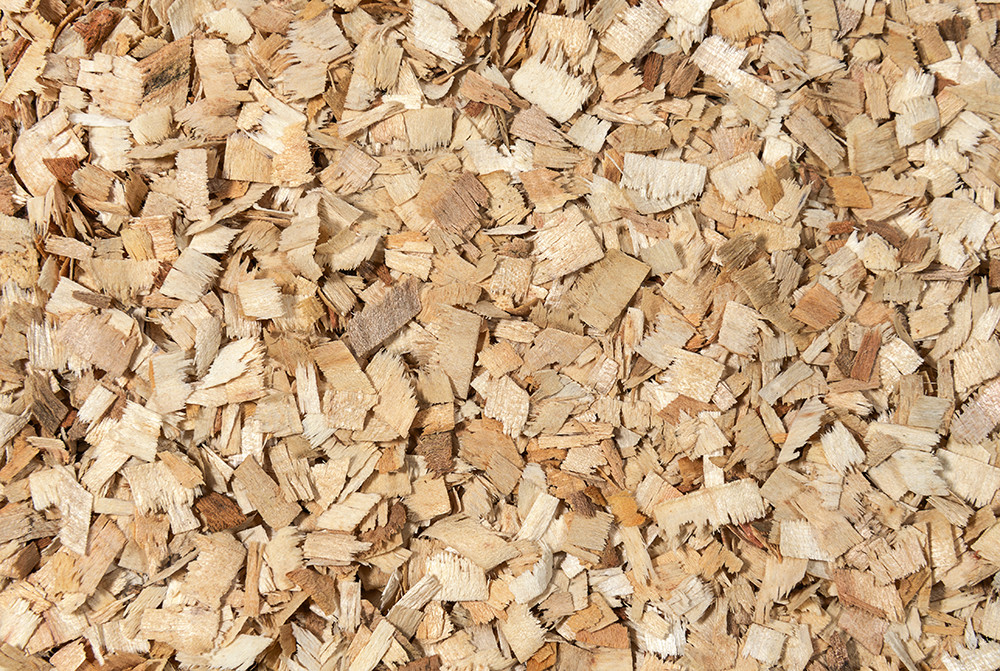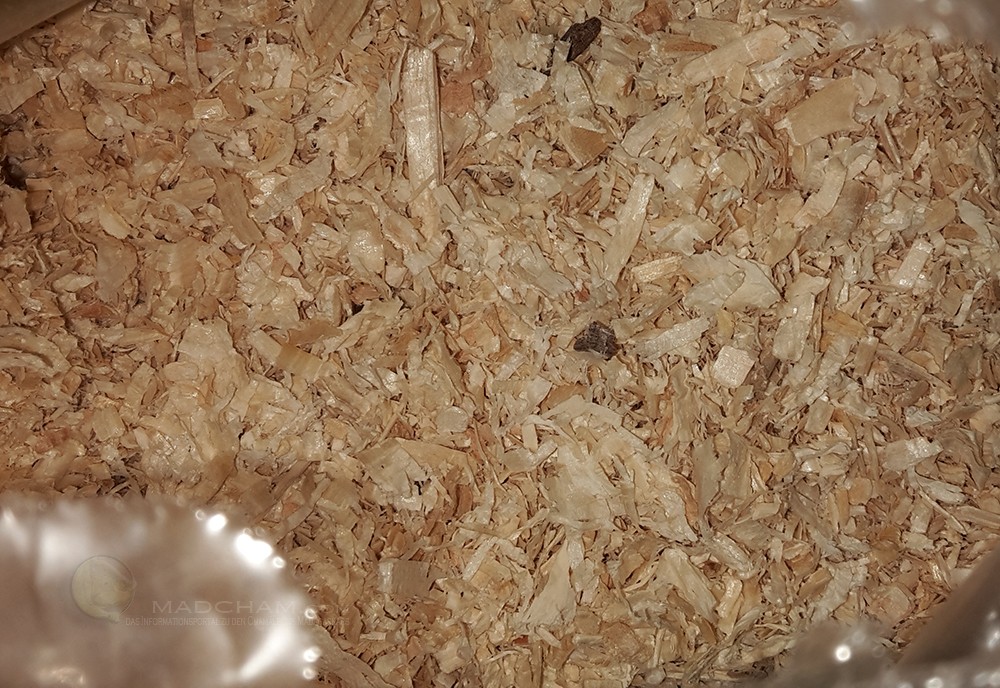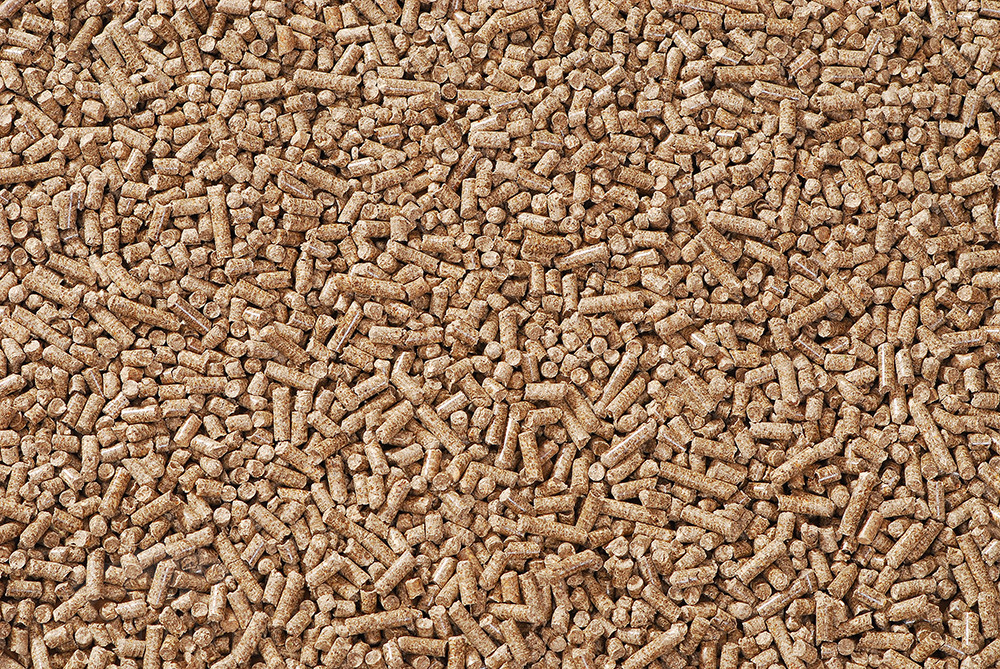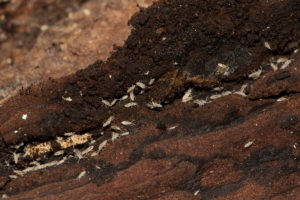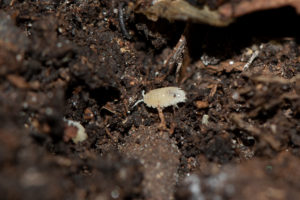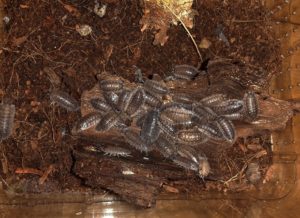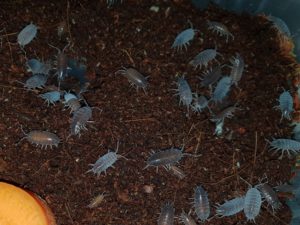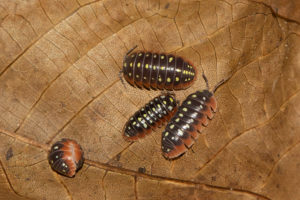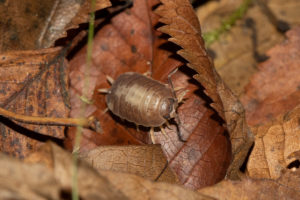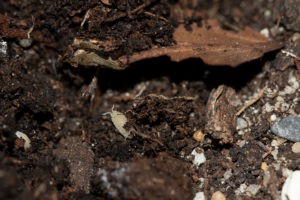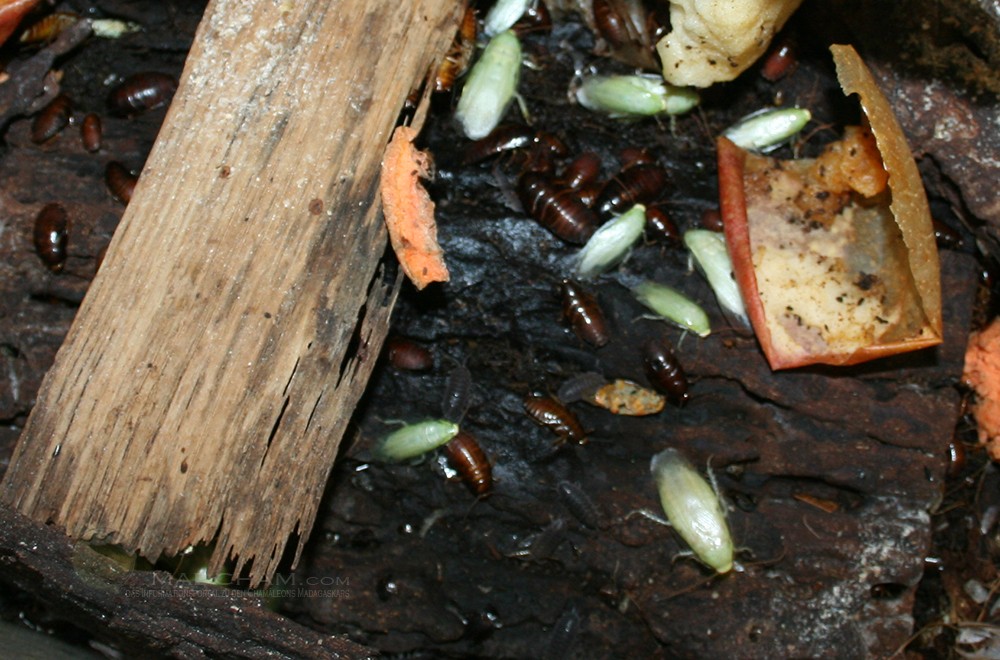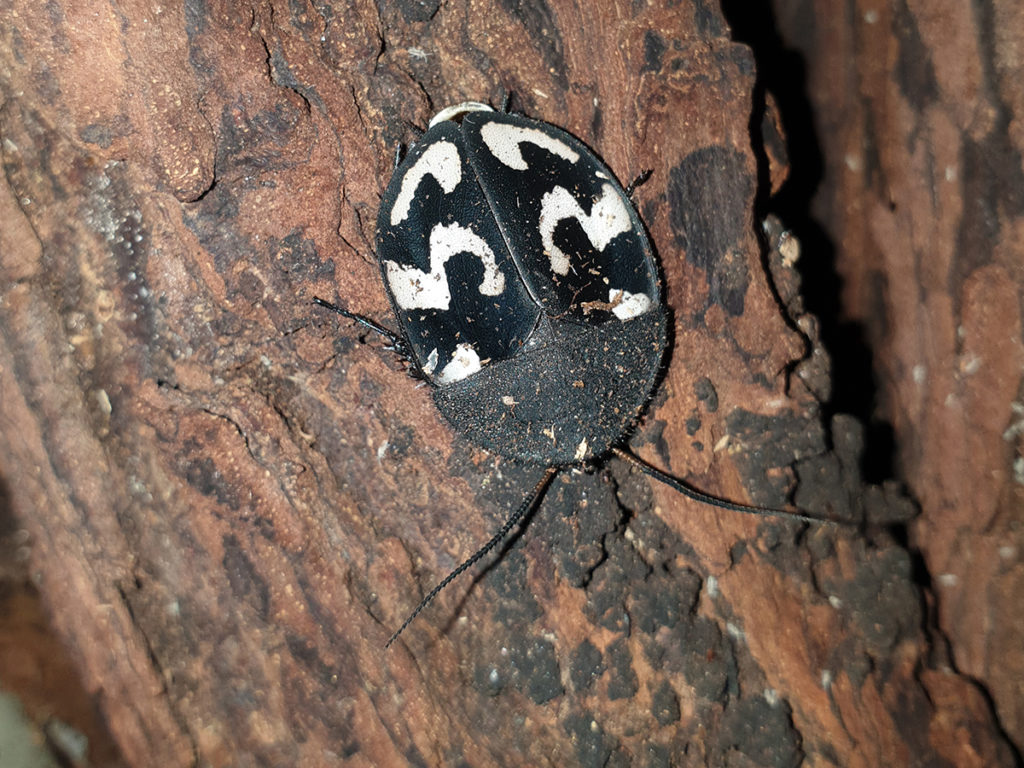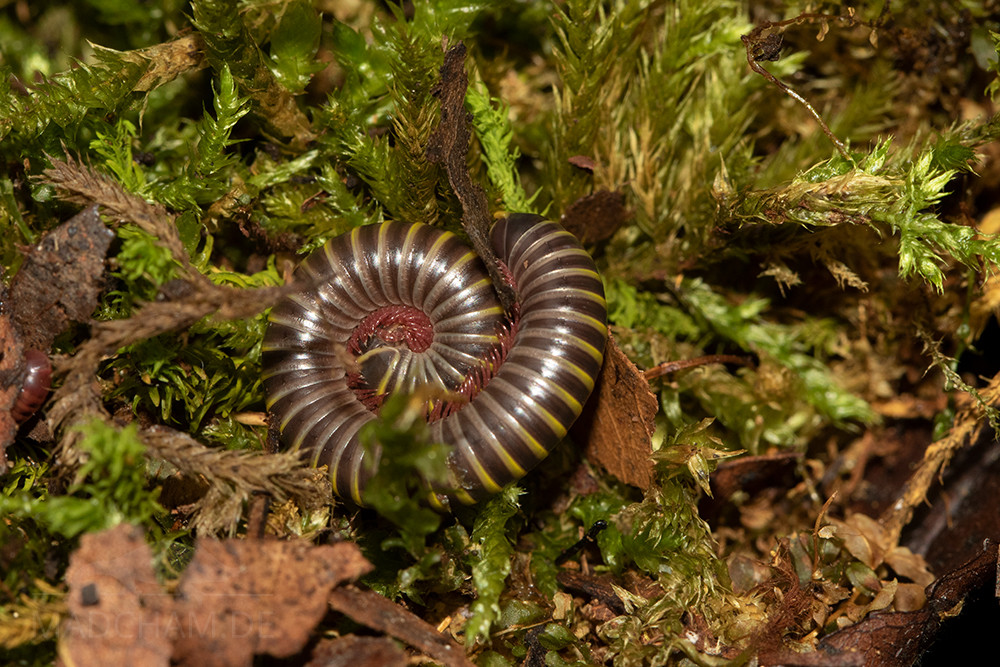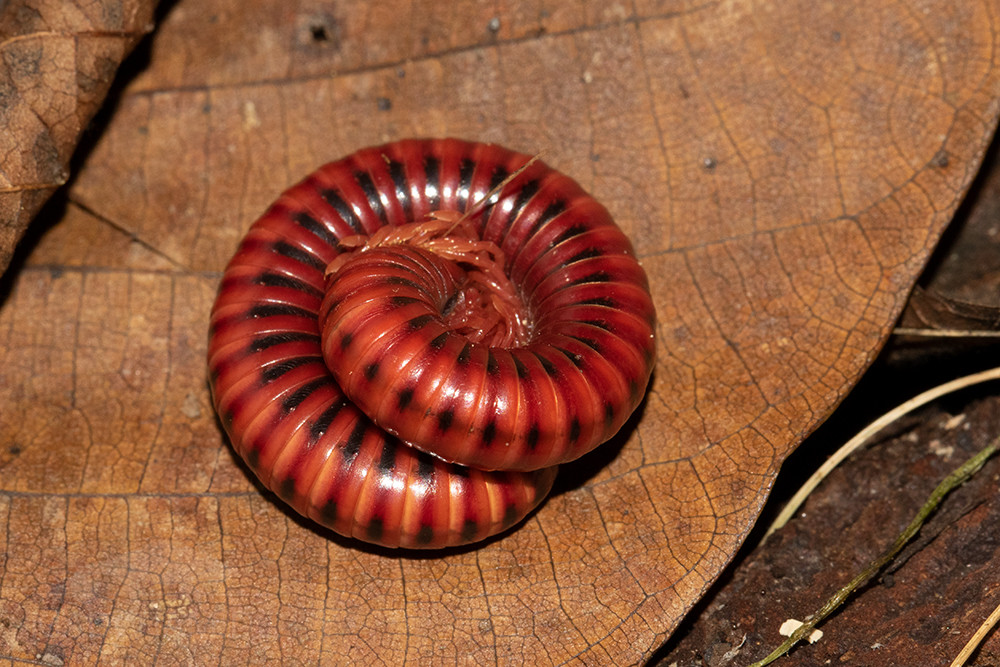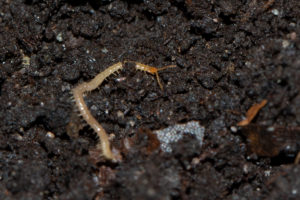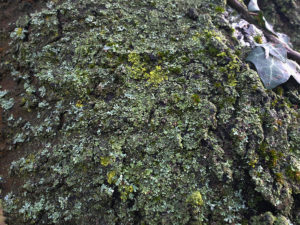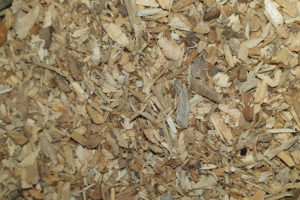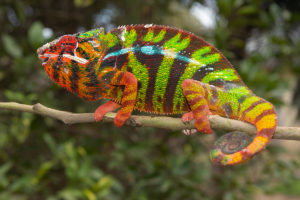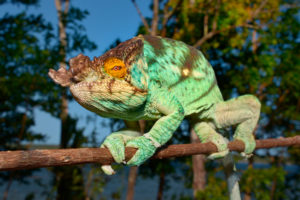Actually, it is quite simple with the soil: Here, too, it is best to orientate yourself on the natural habitat of the chameleons in Madagascar. This article mainly explains the bioactive substrate, its components and advantages, in detail.
Inhaltsverzeichnis
Husbandry without substrate
This type of husbandry is in our eyes only suitable for quarantine of chameleons. A terrarium without a substrate can be kept hygienically clean, but cleaning must be done at least daily. To facilitate the removal of feces, you can lay out kitchen paper or newspaper on the bottom of the terrarium if necessary. For permanent husbandry, “no substrate” is not suitable. Humidity is not maintained, plants must be potted. Female chameleons have no opportunity to lay their eggs in such sparsely equipped terrariums. Potentially harmful germs from the chameleon’s feces can multiply without any competing fauna if hygiene is not scrupulously observed.
Bioactive substrate
For most chameleons, a bioactive substrate has proven itself in terraristics for years. In this case, a natural substrate is recreated, so to speak: With several layers, living plants and a lot of microorganisms that exist in nature. This is an attempt to create a small, self-contained, functioning ecosystem.
The advantages of this substrate are obvious: The humidity in the terrarium is maintained very well. Living plants can be planted directly into the soil. Thus – once well rooted – the water absorption capacity of the substrate is significantly increased. Drippers and sprinklers can run daily if the soil is well rooted, without the need to collect or drain water. Female chameleons can easily lay their eggs without the need for intervention. Feces is completely removed by destructives and do not need to be removed by hand.
Bioactive substrate comes closest to the natural conditions on Madagascar. However, it is important that the bioactive substrate is allowed to “run in” for a few weeks. The plants need time to take root in the soil, the invertebrates need to find a balance or be controlled in their reproduction. Once established, the bioactive substrate is rather low maintenance. However, a living soil actually wants to be cared for and not neglected. The invertebrates used must be regularly fed or provided with additives. Depending on the stocking, some substrate must be replenished or replaced from time to time.
Very important: Substrate and support for the bioactive ground must of course not be heated in the oven before being placed in the terrarium, because this would kill any bacteria, invertebrates and fungi. However, these are indispensable for a natural ground. And, live substrate does not need to be covered with rocks or gravel. The chameleon can shoot or accidentally eat foliage and invertebrates without problems.
The danger of introducing parasites through native reptiles with the soil can be neglected in Germany. In other countries with different climates and many free-living reptiles this can be different. In this case, soil should only be collected where there are no parasite stages on the soil that are potentially infectious to chameleons. The point that small millipedes or snails leave their biotope and crawl through the living room is almost impossible if the substrate is well working in and well cared for. These tiny creatures clearly prefer their moist, native habitat to dry, drafty living room floors.
The natural substrate has only one disadvantage: If plants have taken root in it, it is more difficult for the keeper to dig out laid eggs in the substrate for incubation. Many chameleon females prefer to lay their eggs in the poorly accessible, rooted area of the terrarium. If you want to breed more often, you can offer a terrarium with plants in pots for pregnant females. In large terrariums it is also advisable to prepare a certain, “accessible” corner with some sand in the soil and a branch pointing to it as a place to lay eggs.
Ground height
For keeping chameleon females (also unmated) the substrate should have a minimum height of 20 cm, so that eggs can be laid in it. Chameleon females can also form eggs if unmated. Suitable places to lay eggs prevent females from becoming egg-bound. Otherwise, the higher, the easier it is to care for the substrate.
The different ground layers
The layering of the bioactive ground is shown in the following graphic.
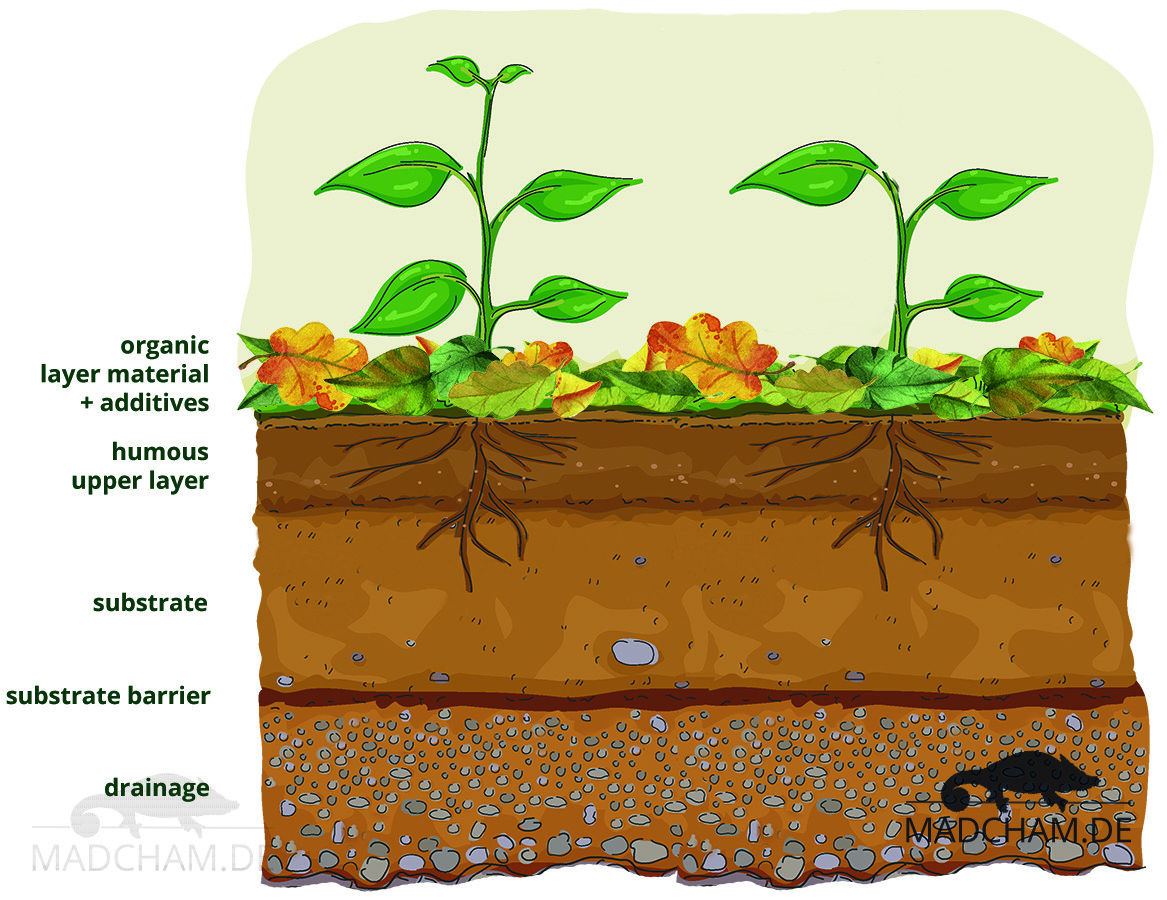
The “organic layer material” is usually simply foliage. Especially freshly fallen leaves from beech, oak, walnut and various fruit trees are suitable. If you have several terrariums and need to keep a supply, you can simply dry the leaves in bags or freeze them. The foliage benefits all life forms in the living soil, provides a natural appearance of the terrarium and is utilized relatively quickly. Various additives can be added to the foliage to keep the substrate alive..
The humous upper layer is the entirety of the very finely decomposed organic matter of the ground. The part of the foliage that has not yet decomposed is the so-called detritus, which is then converted to humus by the invertebrates and bacteria and fungi.
There are several possible substrates. The simplest is to use soil from a deciduous forest, including all the microorganisms it contains. The different substrates are discussed in detail here. If you do not want to use deciduous forest soil, you have to “vaccinate” the substrate, i.e. add invertebrates, mycorrhiza and the like by hand. Without invertebrates and protozoa, the bioactive ground will not work.
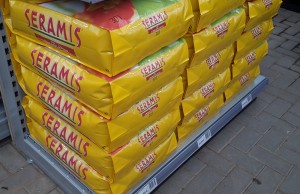
Seramis in bags at the hardware store
Between drainage and substrate you should be sure to put a garden fleece as a substrate barrier. After all, the inhabitants of the revitalized substrate can partially dig. If they get between the drainage balls, they usually die quickly. Without the fleece, soil is quickly washed into the drainage. This worsens the drainage performance.
Terrariums that do not have a drain with filter in the bottom should be provided with a drainage layer under the substrate. For this purpose, expanded clay balls or clay granules (for example, Seramis®), which can be purchased by the sack at the hardware store, are suitable. Be careful when keeping female chameleons: if they are to lay their eggs in the terrarium, the substrate barrier and drainage may prevent them from digging deep.
Substrates
Many different materials can be used as substrates, depending on where the kept chameleon species comes from. Most chameleon species in Madagascar live in rainforests with moist, earthy soils. However, some species also occur in dry forests, which usually have more of a sand-soil mixture as their soil. Only spiny forests, where very few chameleon species live, have a clay, sand or clay-sand mixture soil.
Soil
Moist soil from deciduous forests, including all the microorganisms it contains, is the cheapest and most practical substrate for a bioactive ground. Soil from coniferous forests is not suitable. To avoid carrying buckets of deciduous forest soil, you can use packaged potting or plant soil from the hardware store for mixing. The soil does not necessarily have to be unfertilized, but it should not contain small fertilizer pellets or pieces – the chameleon could accidentally shoot them when eating.
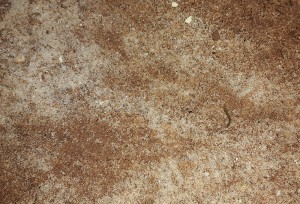
Humid clay-sand-mixture
Clay and sand
A mixture of moistened sand and clay powder provides good digging ability for egg-laying sites in chameleons. The eggs laid in it can be cleaned well. Filling the entire terrarium floor with a clay-sand mixture is not an option. Invertebrates cannot survive well in the substrate in the long term – or you have to use very specialized invertebrates, which are then more laborious to maintain. Also be careful when chameleons shoot feeders on sand: sand likes to stay in the stomach and can lead to blockages.
Peat
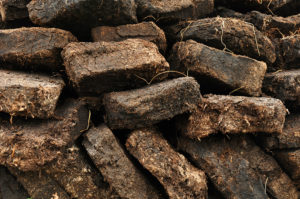
Freshly cut peat
In simple terms, peat consists of incompletely decomposed plants in a bog. Peat can improve soil aeration in the terrarium and store water very well, but is extremely low in nutrients and acidic. Many plants therefore do not cope with pure peat, so it can only be used in the terrarium in substrate mixtures. Peat can be purchased in bags at the hardware store. However, it is critical to see that peat bogs are still being destroyed for peat. Peatlands are sensitive, specialized and above all worth protecting habitats for an abundance of rare animals and plants.
Coconut fibers, coco humus
Coco soil or humus can be bought in pet stores. Usually the substrate is dried, pressed into bricks and sealed in plastic film. If you put the removed bricks into water, they swell and you get a loose, coarse earth-like substrate with many fibers. Coconut substrate holds moisture well. However, in isolated cases, the fibers can cause damage to the gastrointestinal tract if accidentally ingested by the chameleon.
Spaghnum moss
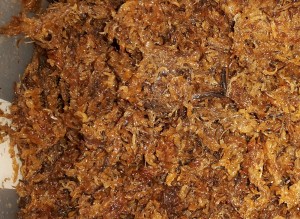
Wet spaghnum moss
Spaghnum is the genus name of the peat or pale mosses. As the name suggests, they grow in nature mainly on nutrient-poor, acidic soil. Similar to coco soil, spaghnum moss is usually sold in pet stores dried and pressed into bricks wrapped in plastic film. When soaked in water, it retains moisture for a very long time. In addition, it is almost impossible to make it mold. Spaghnum is not suitable as the sole substrate for bioactive ground, but it is suitable as an additive for the humous upper layer or as part of a substrate mixture.
Bark mulch, pine bark
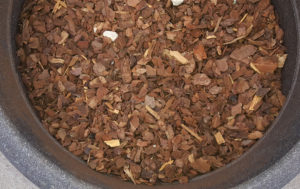
Bark mulch
Bark mulch is shredded tree bark, usually from pines. In the garden, people like to use bark mulch as a cover to make it more difficult for grasses and herbs (in short: “weeds”) to grow. The soil under the bark mulch is better kept moist with the cover, but the mulch itself does not hold moisture. Pine bark tends to mold poorly. However, not all plants tolerate the mulch. As a substrate in the living soil mulch or pine bark alone is not suitable.
Pieces of bark can become problematic if a chameleon accidentally shoots and swallows them with a feeder. The bark is not digested in the gastrointestinal tract and can lead to constipation, in the worst case to a fatal intestinal obstruction. Therefore, we generally do not recommend whole pieces of bark as substrate for chameleon terrariums. You can still use bark finely grounded in substrate mixtures.
ABG mixture
Used in frog husbandry for a long time, rather unknown in chameleon husbandry until now: The substrate mixture of the Atlanta Botanical Gardens (Georgia, USA). The substrate is very drainable, retains moisture well and is therefore in principle well suited for terrariums. Instead of buying ready-made ABG mix, you can make the substrate yourself. It consists of one part crushed spaghnum moss, two parts tree ferns or xaxim litter, two parts pine bark (finely ground), one part peat and one part activated carbon.
Commercially available terrarium soil
A variety of substrates for terrariums is offered in pet shops. Mostly these are mixtures of soil and coconut fibers, soil and peat or coconut fibers and clay or other granules. Far less expensive, you can make your own bioactive ground with deciduous forest soil. The purchase of finished substrates is usually not less work or effort, because you still need to vaccinate them with invertebrates and soil improvers.
Wood chips, wood shavings, small animal litter, cork granules
Any form of wood shavings (sawdust, smoke dust) or cork and wood pieces (even wood pellets) are not suitable as substrate for chameleons in any way. You cannot make a bioactive ground with these substrates, nor can you use them in any other useful way. It molds quickly in damp terrariums, keeps the necessary humidity insufficiently and is not burrowable. Plants cannot root in it and fallen feces is not opposed by any competitive fauna, so pathogenic bacteria and fungi can multiply. In addition, wood or cork chips can become dangerous if a chameleon accidentally shoots and swallows them with a feeder. Wood and cork is not digested in the gastrointestinal tract and can lead to constipation, in the worst case to a fatal intestinal obstruction.
Invertebrates
Springtails
Springtails (Collembola spp.) belong to the “basic equipment” of a bioactive ground. The tropical springtails mostly used in terraristics are up to one millimeter in size. They like humidity, temperatures around 25°C and live absolutely substrate-bound, i.e. they do not leave the substrate. Springtails feed on fungi, food and feeder remains or excrement, but also utilize mold. When “vaccinating” floors with springtails, you should keep in mind that these invertebrates take quite a long time to reproduce. If you want to repopulate a large terrarium with springtails, you should release a correspondingly large number.
Leaf chameleons of the genera Brookesia and Palleon sometimes feed on springtails, for all larger chameleon species springtails are too small as feeders.
Woodlice
Woodlice, along with springtails, are a very good start for a bioactive ground. There are many different species. Most commonly used in terrariums are Cuban Woodlice (Porcellionides prusinos) and the dwarf white isopods (Trichorhina tomentosa). With forest soil you can also get common woodlice (Oniscus asellus), garden woodlice (Porcellio scaber) and common pillbugs (Armadillidium vulgare). Woodlice are very effective in destroying droppings, foliage, and feeder remains. There are a wide variety of species besides those already mentioned. Among them are isopods that cope better with dryness and therefore could be used in less humid terrarium bottoms. If you enjoy these invertebrates, you can even buy quite a few color morphs.
Dew worms and earth worms
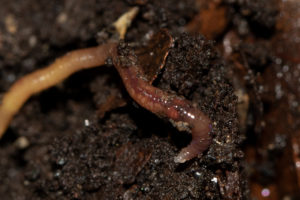
Compost worm
Compost worms (Eisenia fetida) and earthworms or dew worms (Lumbricus terrestris) can decompose the soil with all its components and produce fine humus. This in turn is very suitable as fertilizer for terrarium plants. So putting a handful of worms in the substrate is a good idea. However, there must be good drainage due to the moisture created. If there is a large population of worms in the soil, the substrate also needs to be replaced from time to time before it “bogs down”. You can get compost and dew worms in your local compost or at the nearest tackle store.
Snails
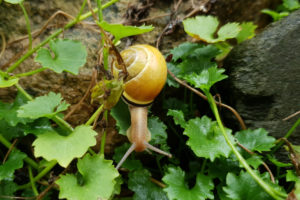
Snail
Snails can enrich a bioactive ground and eat away fungi, but they can also decimate the plants of the terrarium strongly. Shell snails are often shot by chameleons and should not be too large. Slugs are more suitable for the bioactive ground. Some are “delivered” with forest soil. It is better to add smaller species. The pancake snail (Veronicella sloanii) is a quite popular species for terrariums, but it grows relatively large. Snails always need extra feeding and supplements.
Cockroaches
Cockroaches are not always pests, but sometimes very useful. Therefore, some species of cockroaches can be quite practical bottom dwellers in the terrarium. Two criteria are important when choosing the appropriate species: The adult cockroaches should not be able to climb vertically upward over smooth surfaces and the species should live substrate-bound, i.e. it should dry up if it does break out of the terrarium. These requirements are met, for example, by pepper cockroaches (Archimandrita tesselata), Cuban burrowing cockroaches (Hemiblabera brunneri), and dwarf cockroaches (Paraplecta minutissima). In well closed (!) terrariums without cracks on glass and doors, cockroaches whose imagines can fly or cross smooth surfaces can also be used. For example, the green banana cockroach (Panchlora nivea), the bat cave cockroach (Eublaberus distant), or the question mark cockroach (Therea olegrandjeani) are suitable. Be cautious, cockroaches might end up as snacks in your chameleon.
Translated with www.DeepL.com/Translator (free version)
Millipedes
Millipedes are very good recyclers and thus in principle a good “cleaning crew”. They eat leaves, carrion, mold, dead plant debris and almost anything else that falls to the ground. Millipedes are suitable only for moist soils and like a thick humus layer. Husbandry of some species is easy, others multiply only under certain conditions. So you should read well if you want to put millipedes on the terrarium floor. Generally you should buy them only if you as a keeper are willing to take care of these animals carefully like you do with the chameleon (see additives) and to control the population constantly. If you are just starting with terraristics or chameleons, it is better to postpone the topic until later.
For chameleons, do not put too large species millipedes in the substrate. Medium and large chameleons usually try to prey on the millipedes despite the warning color. However, the invertebrates have defensive secretions and can cause mucosal damage. In addition, nocturnal large species may disturb sleeping chameleons. Thus, only millipedes that spend a lot of time under the substrate and remain relatively small should be placed in the terrarium as beneficial arthropods. Species that might be considered are Spirostreptus brachycerus (max. 90 mm) and Anadenobolus monilicornis (max. 50 mm), but also other species that remain small such as Centrobolus splendidus (max. 80 mm).
Earwigs, ants and other invertebrates
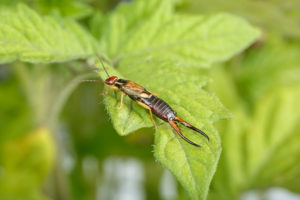
Earwig
Earwigs or earworms (Dermaptera spp.) are of limited suitability for live substrate. They feed on plants, but are also very good hunters. Despite their small size, earwigs can therefore even overpower feeders that were actually intended for the chameleon. Likewise, depending on the species used, they can completely wipe out other beneficial insects in the substrate, such as cockroaches. In addition, earwigs are very mobile and regularly leave the substrate. They also do not mind dryness. From time to time, you get a few harmless earwigs “delivered” with soil from the deciduous forest.
For advanced keepers and insect lovers, ants, termites and beetles can be interesting for a bioactive ground, for the average keeper they are not recommended. Termites and ants are quite likely to move around the room instead of just staying in the terrarium. Rose beetles, while very nice to look at, are clearly too high protein snacks including their larvae and are shot by chameleons as feeders.
Other invertebrates are usually brought directly into the terrarium with the forest soil. Most of them, for example small centipedes like the stonecreeper, are harmless and do not reproduce indefinitely.
Bacteria
Bacteria are single-celled organisms. They live on all surfaces, on and in the soil, even on and in humans and just as much on and in the chameleon. Bacteria are virtually infinite around us and on us. They are very important for the quality of the soil. Especially many bacteria are found directly around plant roots, the so-called rhizosphere.
So-called decomposer bacteria (destructants) do exactly what their name suggests: they decompose everything that invertebrates and fungi cannot, even pollutants. From this, they produce nutrients for plants, among other things. This ensures better plant growth, both in the forest and in the terrarium. Actinomycetes are a large group of the destruents and belong to a kind of transitional form between bacteria and fungi. By the way, the bacterial species Streptomyces coelicolor, which belongs to this group, provides the typical “earth smell”. Potentially pathogenic bacteria unfortunately also live in the soil. Unfortunately, they cannot be specifically removed, but a balance must be created between them and the “good” bacteria.
Since bacterial cultures are not available for “vaccinating” dead soil, it is best to use a large bucket of soil from the nearby deciduous forest to create the appropriate bacterial fauna in the substrate. With this you usually also get some invertebrates to complete the “cleaning crew” of the soil.
Fungi
The spores of real mushrooms are usually brought into the terrarium with forest soil. Above the ground, the fruiting bodies, i.e. the visible part of the mushroom, grow only under certain conditions. Small mushrooms do not necessarily have to be removed from the terrarium, but to be on the safe side you should briefly look up whether they are potentially poisonous mushrooms.
By the way, lichens are symbioses between fungi and bacteria, mostly green algae or cyanobacteria. Crustose lichens are often brought into the terrarium with branches of old fruit trees or from the forest. They are harmless. Regularly kept moist, they even remain quite a while on the branches in the terrarium.
Mycorrhiza
Mycorrhiza is a symbiosis between certain fungi and the roots of a plant. Around 90% of all plants can form such symbioses, including many terrarium plants. The mycorrhizal fungi provide the plant with minerals and water, while the plant gives the fungi some of its photosynthesis products, mainly carbohydrates. Mycorrhizal fungi pass through the entire substrate with their hyphae and use them to transport nutrients to the plants. All hyphae together are called the mycelium. The beneficial properties of mycorrhizal fungi can also be used in the chameleon terrarium. Either you add them to the substrate with deciduous forest soil or buy them as granules in garden centers or online stores to improve the substrate with them.
Additives
To keep the bioactive ground with all its inhabitants alive, the substrates and especially the organic layer materials must be replenished from time to time and additives must be added.
Protein food should always be added without the chameleons being able to eat it themselves. It is therefore best spread under the layer of foliage. Protein food prevents invertebrates from nibbling each other in search of protein sources or even going after the terrarium inhabitant. It also protects freshly laid chameleon eggs in the soil from being eaten in the short term. Suitable protein foods include kibbles of commercial dry cat or dog food, dried silkworms, or dried mealworms from the pet store. Brewer’s yeast can also be sprinkled occasionally under the humus top layer. Springtails and woodlice like to use the brewer’s yeast tablets as a source of protein.
Calcium is also essential for many creatures of the bioactive ground. Millipedes and snails, for example, depend on it. A piece of cuttlebone lying under the foliage or crumbled eggshells are sufficient.
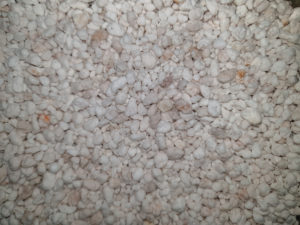
Perlite
White rotten wood is eaten by many invertebrates. Woodlice, beetles and millipedes decompose it in a very short time. White rotten wood can be found in the forest, but it can also be bought online. You can put larger pieces on the foliage or sprinkle it crushed under the foliage directly on the substrate. In the long run, you can also make your own white rotted wood from wood shavings using bacterial fermentation, the result is called flake soil. This substrate can be purchased online in large bags.
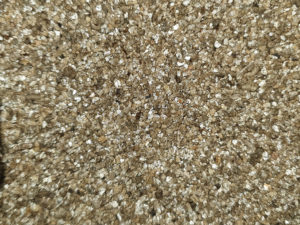
Vermiculite
Xaxim consists of dried parts of tree ferns and countless seeds of tropical mosses and microplants contained therein. Xaxim fibers can improve the living substrate by bringing new plant material and more microorganisms.
Vermiculite is a clay mineral, perlite is a volcanic glass. Both can improve air permeability in the soil substrate and protect the substrate from excessive compaction. They also store water and protect against waterlogging. In chameleon husbandry, both perlite and vermiculite are used primarily for egg incubation. In the bottom substrate, they should not be present in the upper layer. Material accidentally ingested with food animals is indigestible for chameleons and can lead to intestinal obstruction.
Vegetable carbon, mixed into the substrate, can help improve the soil. Vegetable carbon is usually used in combination with compost, serving as a carrier for nutrients and a habitat for bacteria and fungi.

